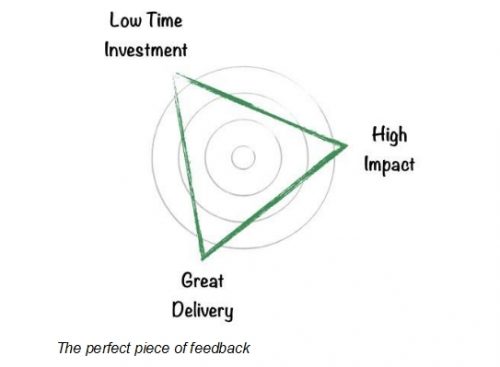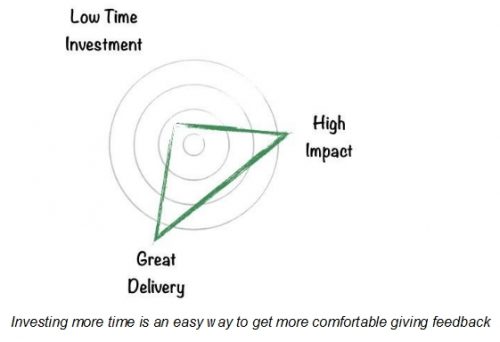Agile approaches are used to generate quicker feedback that supports continuous improvement. Giving proper feedback is important between Scrum team members or with other project stakeholders. This is however hard and this article provides some hints on how to make it easier.
Author: Tom Sommer, Director of Engineering at Redbubble, https://www.linkedin.com/in/leadintech/
Here I am, lying awake in bed since 4 AM. My brain is busy working through a problem with our neighbour. He loves cars. And most of all, he loves to tinker with cars. His hobby transforms the dead end street we share with him into a car park. And more often than not, into a full-blown car garage.
Why am I telling you this? Because it comes down to one single thing we can do to improve the situation… Talk to our neighbour and tell him about our concerns. Give feedback.
Truth is, giving feedback is hard. The reason why I am lying awake is not that I have the “I need to give feedback” moment. No, that realisation came a few weeks ago. The reason is that I am putting it off. Day after day, week after week. Always finding another excuse.
One reason is about relationships, which are a big part of giving feedback. After all, we do not want to hurt someone or make them feel bad.
But there is more. For better or for worse, we are aiming high. Very high. We want to be perfect.
The Perfect Piece Of Feedback
On an average day, chances are there are at least a handful of opportunities for giving feedback. That is heaps! But most of the time we bail. We are great at deciding that this is not the right time. And I believe this decision happens based on three aspects:

- Time Investment. How much time do I have to spend on the feedback preparation?
- Delivery. How will I deliver the feedback? Will I get straight to the point? Clearly articulated? Will the feedback be well understood by the receiver?
- Impact. How impactful will the feedback be? Will it help someone improve? How constructive is it?
And here is the problem… We are aiming for the perfect combination: Low time investment, spot-on delivery, high impact.
Do I need to spend 10 minutes to come up with a quick narrative? Too much effort, let’s bail.
Can I get my point across? Probably not, let’s bail.
Will the person take my advice on board? Unlikely, let’s bail.
I bet that in most cases the answer to at least one of those three questions is questionable at best. So we take the easy option — No feedback. And there goes another opportunity…
Instead of acknowledging that we are not perfect, we use any potential deviation from perfect to stay quiet.
Lowering The Bar
If you are anything like me, then this is the worst possible outcome. In my view, any feedback is better than none.
The behaviour is understandable though. Sharing feedback is a skill. Getting to a level where clear, impactful feedback does not take hours to prepare requires time and practice. Lots of practice. And if we are consistently missing opportunities, we will never get better at it.
How can we break this reinforcing cycle?
Practice trumps quality. In other words, at least one of our three quality dimensions has to be relaxed. The good news is, by practising often the quality will improve. Which, over time, will get us closer to that elusive goal of good feedback.
Option 1: High time investment
The first approach is quite straightforward: Put in a conscious effort to prepare every piece of feedback.

This option does not work very well for those with an already slammed schedule. But it is a great option if you can afford to spend 30–60 minutes each day reflecting and preparing:
- Replay the interactions you had with others during the day. The emails, meetings, chats in the hallway.
- Recall what you felt at the time and whether you are happy about the impact on you.
- In the last step, craft the feedback itself. For example by using the Situation, Behaviour, Impact (SBI) framework.
Option 2: Suboptimal delivery & Low impact
Investing more time is not an option for everybody though, simply because is already scarce for most of us.

In this case, I suggest coming from the other direction: What if we could relax the conditions around delivery and impact?
What would it take to be comfortable giving feedback that might not make a lasting impact, and might not be as clearly articulated as it could be? With the goal to practice, practice, practice.
This might sound a bit scary. But I do not suggest you shoot from the hip in any situation you feel like it, ignoring who you are talking to.
We can set us up in a way that allows us to practice, without a negative effect on our work and relationships:
- Stay Positive. We often forget that saying something nice is also feedback. And it is a great way to practice. Stick with SBI (see below) and voilà, here you are giving feedback.
- Training Partner. Lots of folks are more than happy to help you practice a new skill. Find 2–3 colleagues, share with them what you are trying to achieve, and that you will give them regular feedback. It does not matter what about. Then after a while ask them for feedback on your feedback… Magic!
Feelings
Practice is incredibly important and the only way we get better.
And no matter what level of feedback giving you are on, there is a framework to maximise your chances of a good delivery. To ensure your feedback is received well and influences change.
Something that might feel a little counter-intuitive at first. The key is to talk about the impact on yourself and your feelings. Yes, Feelings.
This might sound a bit odd… Is not feedback all about telling the other person how they should behave? Let them know what they have done wrong? Make them aware that you know better than them?
Problem is, people do not like to be told what they should do. Most of us react pretty badly if someone highlights our shortcomings. When we provide feedback like this, we should be scared of giving it. Of course, there is a high chance the other person gets offended. Try putting yourself in the same situation.
The only way someone really takes in what you have to say, is to talk about yourself. In particular your feelings. You have to share the impact on you. Not what that person did wrong.
The framework I like to use for this is SBI. Describe the Situation as it happened, the Behaviour you observed, and the Impact it had on you. And the best way to share impact is by sharing your feelings. It is that simple.
Let me illustrate this concept with the example from the beginning of the article… my neighbour’s car obsession:
Bad Feedback. “Hey. I have to say you’re a pretty bad neighbour for having so many cars. I think you should sell a few because frankly, who needs so many of them and it’s pretty annoying to us.”
Better Feedback. “Hey mate. How are things? Do you have five minutes to chat about something? I wanted to talk to you about the car situation. We feel a bit disrespected because our shared dead-end turns into a car park or even a garage most days. For example, this past Saturday.”
Very different, right? And while I am addressing the situation in both cases, chances are the second version is more successful. No one can argue with your feelings!
Recap
Giving feedback can be scary. We try to avoid it wherever we can. For better or worse, we want our feedback to be perfect: low time investment, spot-on delivery, high impact.
If we want to get better at giving feedback, we have to start practicing. Quantity beats Quality. At least one of the requirements around time, delivery and impact needs to be relaxed.
And to maximise our impact, the key is to use the Situation, Behaviour, Impact (SBI) framework and, most importantly, talk about your feelings.
About the Author
Tom Sommer is a Director of Engineering at Redbubble, where he wears multiple hats, including Delivery Lead, Coach and Manager. Tom has been sharing his thoughts and insights for several years now, and write regularly about leadership, personal growth and feedback. His articles can be found at https://medium.com/@tom.leadintech.


Feelings are less important than outcomes. If you cannot describe the negative outcome for a situation, then maybe there isn’t really a problem. Talking about feelings in the context of a specific negative outcome is different. “It took 20 minutes to move all those cars so we could get to our appointment. It is very frustrating to run late. How would you feel if we did that to you?”, etc.